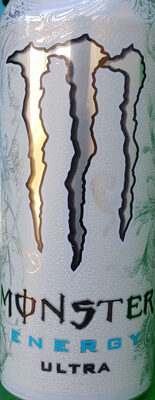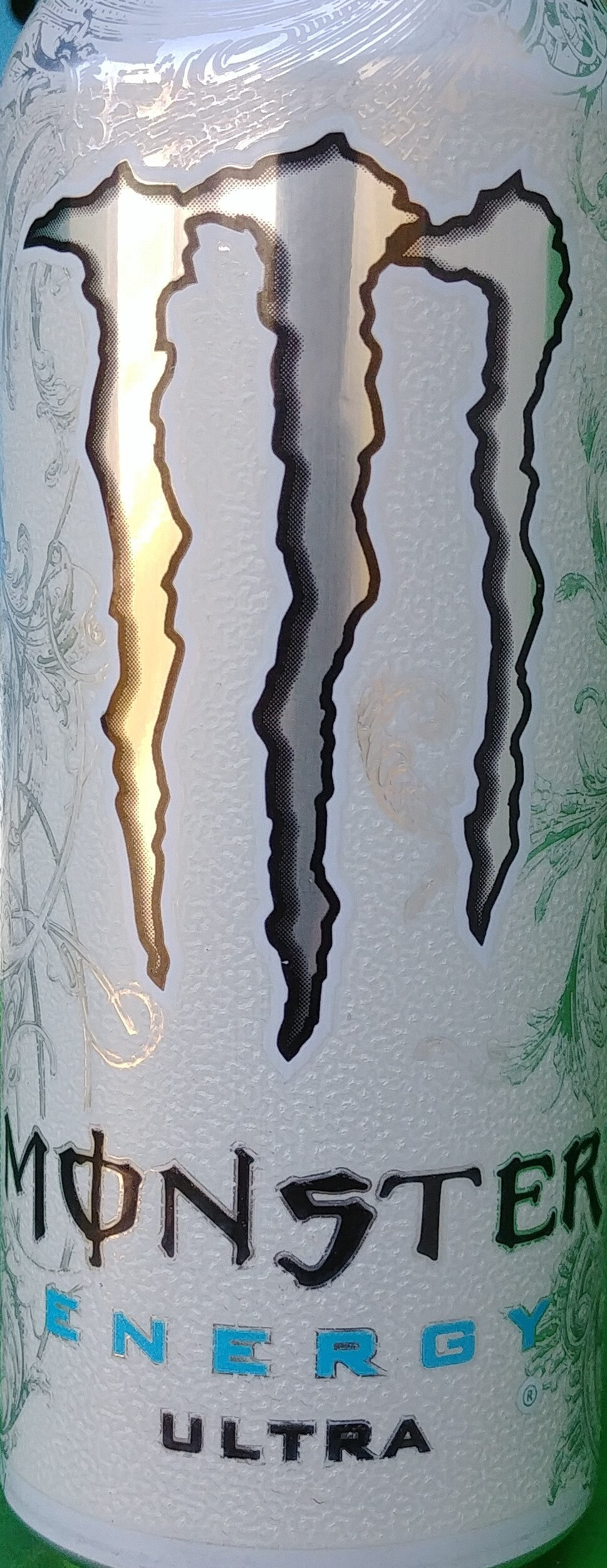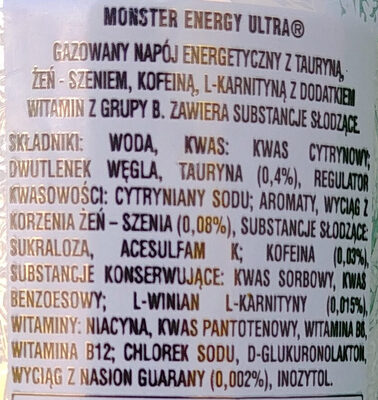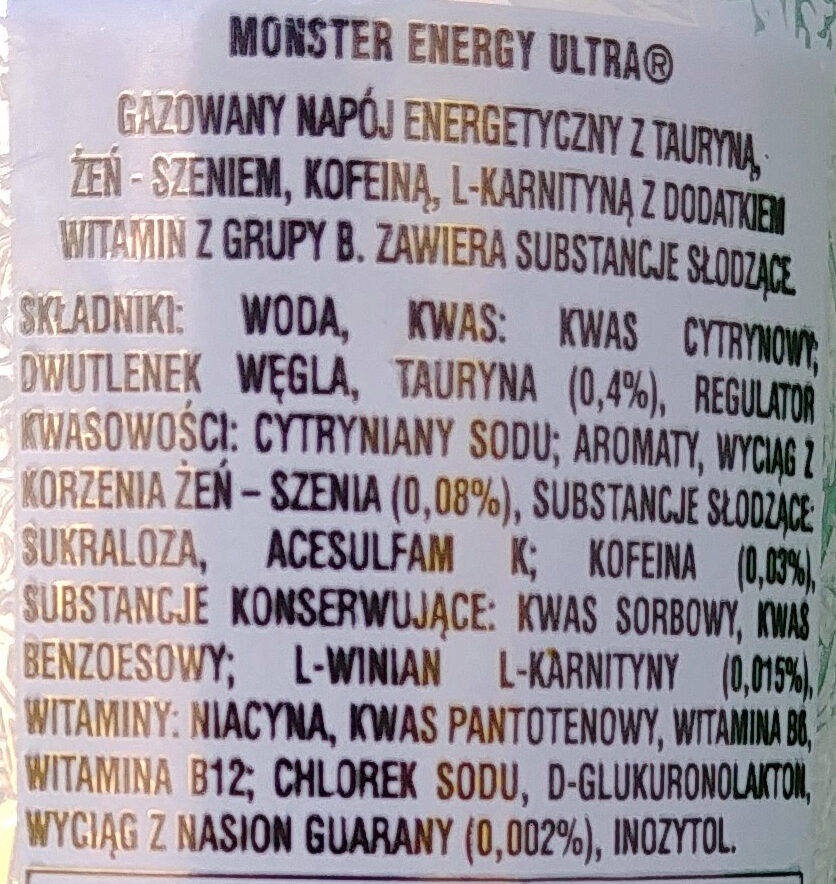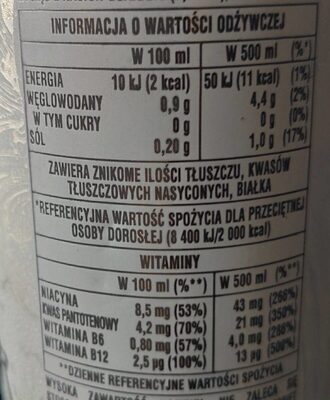Ajuda'ns a fer que la transparència alimentària sigui la norma!
Com a organització sense ànim de lucre, depenem de les vostres donacions per continuar informant els consumidors de tot el món sobre tot allò què mengen.
La revolució alimentària comença amb tu!
Monster energy ultra - Monster Energy Company - 500 ml
Monster energy ultra - Monster Energy Company - 500 ml
Aquesta pàgina del producte no està completa. Podeu ajudar a completar-la editant-la i afegint-hi més dades a partir de les fotos ja disponibles, o fent-ne més amb l'aplicació de androide o iPhone / iPad. Gràcies!
×
Codi de barres: 5060337500258 (EAN / EAN-13)
Nom comú: napój energetyczny bez cukru
Quantitat: 500 ml
Empaquetament: en:Metal, en:Recyclable Metals, Alumini
Marques: Monster Energy Company
Categories: Begudes, Begudes ensucrades artificialment, en:Energy drinks
Enllaç a la pàgina del producte en el lloc oficial del productor: http://www.monsterenergy.com
Botigues: Żabka
Matching with your preferences
Salut
Ingredients
-
26 ingredients
: WODA, KWAS: KWAS CYTRYNOWY, DWUTLENEK WĘGLA, TAURYNA (0,4%), REGULATOR KWASOWOŚCI: CYTRYNIANY SODU; AROMATY, WYCIĄG Z KORZENIA ŻEN-SZENIA (0,08%), SUBSTANCJE SŁODZĄCE SUKRALOZA, ACESULFAM K; KOFEINA (0,03%), SUBSTANCJE KONSERWUJĄCE: KWAS SORBOWY, KWAS BENZOESOWY; L-WINIAN L-KARNITYNY (0,015%) WITAMINY: NIACYNA, KWAS PANTOTENOWY, WITAMINA B6, WITAMINA B12; CHLOREK SODU, D-GLUKURONOLAKTON, WYCIĄG Z NASION GUARANY (0,002%), INOZYTOL.
Processament d'aliments
-
Aliments ultra processats
Elements que indiquen que el producte està al grup 4 - Aliments i begudes ultraprocessats:
- Additiu: E290 - Diòxid de carboni
- Additiu: E950 - Acesulfam K
- Additiu: E955 - Sucralosa
- Ingredient: Aromes
- Ingredient: Edulcorant
Els productes alimentaris es classifiquen en 4 grups segons el seu grau de processament:
- Aliments no processats o mínimament processats
- Ingredients culinaris processats
- Aliments processats
- Aliments ultra processats
La determinació del grup es fa en funció de la categoria del producte i dels ingredients que conté.
Additius
-
E200 - Àcid sòrbic
Sorbic acid: Sorbic acid, or 2‚4-hexadienoic acid, is a natural organic compound used as a food preservative. It has the chemical formula CH3-CH-4CO2H. It is a colourless solid that is slightly soluble in water and sublimes readily. It was first isolated from the unripe berries of the Sorbus aucuparia -rowan tree-, hence its name.Origen: Wikipedia (Anglès)
-
E210 - Àcid benzoic
Benzoic acid: Benzoic acid , C7H6O2 -or C6H5COOH-, is a colorless crystalline solid and a simple aromatic carboxylic acid. The name is derived from gum benzoin, which was for a long time its only known source. Benzoic acid occurs naturally in many plants and serves as an intermediate in the biosynthesis of many secondary metabolites. Salts of benzoic acid are used as food preservatives and benzoic acid is an important precursor for the industrial synthesis of many other organic substances. The salts and esters of benzoic acid are known as benzoates .Origen: Wikipedia (Anglès)
-
E290 - Diòxid de carboni
Carbon dioxide: Carbon dioxide -chemical formula CO2- is a colorless gas with a density about 60% higher than that of dry air. Carbon dioxide consists of a carbon atom covalently double bonded to two oxygen atoms. It occurs naturally in Earth's atmosphere as a trace gas. The current concentration is about 0.04% -410 ppm- by volume, having risen from pre-industrial levels of 280 ppm. Natural sources include volcanoes, hot springs and geysers, and it is freed from carbonate rocks by dissolution in water and acids. Because carbon dioxide is soluble in water, it occurs naturally in groundwater, rivers and lakes, ice caps, glaciers and seawater. It is present in deposits of petroleum and natural gas. Carbon dioxide is odorless at normally encountered concentrations, however, at high concentrations, it has a sharp and acidic odor.As the source of available carbon in the carbon cycle, atmospheric carbon dioxide is the primary carbon source for life on Earth and its concentration in Earth's pre-industrial atmosphere since late in the Precambrian has been regulated by photosynthetic organisms and geological phenomena. Plants, algae and cyanobacteria use light energy to photosynthesize carbohydrate from carbon dioxide and water, with oxygen produced as a waste product.CO2 is produced by all aerobic organisms when they metabolize carbohydrates and lipids to produce energy by respiration. It is returned to water via the gills of fish and to the air via the lungs of air-breathing land animals, including humans. Carbon dioxide is produced during the processes of decay of organic materials and the fermentation of sugars in bread, beer and wine making. It is produced by combustion of wood and other organic materials and fossil fuels such as coal, peat, petroleum and natural gas. It is an unwanted byproduct in many large scale oxidation processes, for example, in the production of acrylic acid -over 5 million tons/year-.It is a versatile industrial material, used, for example, as an inert gas in welding and fire extinguishers, as a pressurizing gas in air guns and oil recovery, as a chemical feedstock and as a supercritical fluid solvent in decaffeination of coffee and supercritical drying. It is added to drinking water and carbonated beverages including beer and sparkling wine to add effervescence. The frozen solid form of CO2, known as dry ice is used as a refrigerant and as an abrasive in dry-ice blasting. Carbon dioxide is the most significant long-lived greenhouse gas in Earth's atmosphere. Since the Industrial Revolution anthropogenic emissions – primarily from use of fossil fuels and deforestation – have rapidly increased its concentration in the atmosphere, leading to global warming. Carbon dioxide also causes ocean acidification because it dissolves in water to form carbonic acid.Origen: Wikipedia (Anglès)
-
E330 - Acid citric
Citric acid: Citric acid is a weak organic acid that has the chemical formula C6H8O7. It occurs naturally in citrus fruits. In biochemistry, it is an intermediate in the citric acid cycle, which occurs in the metabolism of all aerobic organisms. More than a million tons of citric acid are manufactured every year. It is used widely as an acidifier, as a flavoring and chelating agent.A citrate is a derivative of citric acid; that is, the salts, esters, and the polyatomic anion found in solution. An example of the former, a salt is trisodium citrate; an ester is triethyl citrate. When part of a salt, the formula of the citrate ion is written as C6H5O3−7 or C3H5O-COO-3−3.Origen: Wikipedia (Anglès)
-
E331 - Citrats de sodi
Sodium citrate: Sodium citrate may refer to any of the sodium salts of citrate -though most commonly the third-: Monosodium citrate Disodium citrate Trisodium citrateThe three forms of the salt are collectively known by the E number E331. Sodium citrates are used as acidity regulators in food and drinks, and also as emulsifiers for oils. They enable cheeses to melt without becoming greasy.Origen: Wikipedia (Anglès)
-
E950 - Acesulfam K
Acesulfame potassium: Acesulfame potassium - AY-see-SUL-faym-, also known as acesulfame K -K is the symbol for potassium- or Ace K, is a calorie-free sugar substitute -artificial sweetener- often marketed under the trade names Sunett and Sweet One. In the European Union, it is known under the E number -additive code- E950. It was discovered accidentally in 1967 by German chemist Karl Clauss at Hoechst AG -now Nutrinova-. In chemical structure, acesulfame potassium is the potassium salt of 6-methyl-1‚2,3-oxathiazine-4-3H--one 2‚2-dioxide. It is a white crystalline powder with molecular formula C4H4KNO4S and a molecular weight of 201.24 g/mol.Origen: Wikipedia (Anglès)
-
E955 - Sucralosa
Sucralose: Sucralose is an artificial sweetener and sugar substitute. The majority of ingested sucralose is not broken down by the body, so it is noncaloric. In the European Union, it is also known under the E number E955. It is produced by chlorination of sucrose. Sucralose is about 320 to 1‚000 times sweeter than sucrose, three times as sweet as both aspartame and acesulfame potassium, and twice as sweet as sodium saccharin. Evidence of benefit is lacking for long-term weight loss with some data supporting weight gain and heart disease risks.It is stable under heat and over a broad range of pH conditions. Therefore, it can be used in baking or in products that require a long shelf life. The commercial success of sucralose-based products stems from its favorable comparison to other low-calorie sweeteners in terms of taste, stability, and safety. Common brand names of sucralose-based sweeteners are Splenda, Zerocal, Sukrana, SucraPlus, Candys, Cukren, and Nevella. Canderel Yellow also contains sucralose, but the original Canderel and Green Canderel do not.Origen: Wikipedia (Anglès)
Anàlisi dels ingredients
-
No conté oli de palma
No s'han detectat ingredients que continguin oli de palma
Ingredients no reconeguts: pl:wyciąg-z-korzenia-żen-szenia, pl:d-glukuronolakton, pl:wyciąg-z-nasion-guaranyAlguns ingredients no s'han pogut reconèixer.
Necessitem la teva ajuda!
Podeu ajudar-nos a reconèixer més ingredients i analitzar millor la llista d'ingredients d'aquest producte i d'altres mitjançant:
- Editeu aquesta pàgina de producte per corregir les faltes d’ortografia de la llista d’ingredients i/o per eliminar els ingredients d’altres idiomes i frases que no estiguin relacionades amb els ingredients.
- Afegiu entrades, sinònims o traduccions noves a les nostres llistes multilingües d’ingredients, mètodes de processament d’ingredients i etiquetes.
Uniu-vos al canal #ingredients del nostre espai de discussió a Slack i/o apreneu sobre l'anàlisi dels ingredients en la nostra wiki, si voleu ajudar. Gràcies!
-
No és vegà
Ingredients no vegans: en:L-carnitine-L-tartrateAlguns ingredients no s'han pogut reconèixer.
Necessitem la teva ajuda!
Podeu ajudar-nos a reconèixer més ingredients i analitzar millor la llista d'ingredients d'aquest producte i d'altres mitjançant:
- Editeu aquesta pàgina de producte per corregir les faltes d’ortografia de la llista d’ingredients i/o per eliminar els ingredients d’altres idiomes i frases que no estiguin relacionades amb els ingredients.
- Afegiu entrades, sinònims o traduccions noves a les nostres llistes multilingües d’ingredients, mètodes de processament d’ingredients i etiquetes.
Uniu-vos al canal #ingredients del nostre espai de discussió a Slack i/o apreneu sobre l'anàlisi dels ingredients en la nostra wiki, si voleu ajudar. Gràcies!
-
Es desconeix si és vegetarià
Ingredients no reconeguts: pl:wyciąg-z-korzenia-żen-szenia, Cobalamina, Clorur de sodi, pl:d-glukuronolakton, pl:wyciąg-z-nasion-guaranyAlguns ingredients no s'han pogut reconèixer.
Necessitem la teva ajuda!
Podeu ajudar-nos a reconèixer més ingredients i analitzar millor la llista d'ingredients d'aquest producte i d'altres mitjançant:
- Editeu aquesta pàgina de producte per corregir les faltes d’ortografia de la llista d’ingredients i/o per eliminar els ingredients d’altres idiomes i frases que no estiguin relacionades amb els ingredients.
- Afegiu entrades, sinònims o traduccions noves a les nostres llistes multilingües d’ingredients, mètodes de processament d’ingredients i etiquetes.
Uniu-vos al canal #ingredients del nostre espai de discussió a Slack i/o apreneu sobre l'anàlisi dels ingredients en la nostra wiki, si voleu ajudar. Gràcies!
-
Detalls de l'anàlisi dels ingredients
Necessitem la teva ajuda!
Alguns ingredients no s'han pogut reconèixer.
Necessitem la teva ajuda!
Podeu ajudar-nos a reconèixer més ingredients i analitzar millor la llista d'ingredients d'aquest producte i d'altres mitjançant:
- Editeu aquesta pàgina de producte per corregir les faltes d’ortografia de la llista d’ingredients i/o per eliminar els ingredients d’altres idiomes i frases que no estiguin relacionades amb els ingredients.
- Afegiu entrades, sinònims o traduccions noves a les nostres llistes multilingües d’ingredients, mètodes de processament d’ingredients i etiquetes.
Uniu-vos al canal #ingredients del nostre espai de discussió a Slack i/o apreneu sobre l'anàlisi dels ingredients en la nostra wiki, si voleu ajudar. Gràcies!
: WODA, KWAS (KWAS CYTRYNOWY), DWUTLENEK WĘGLA, TAURYNA 0.4%, REGULATOR KWASOWOŚCI (CYTRYNIANY SODU), AROMATY, WYCIĄG Z KORZENIA ŻEN-SZENIA 0.08%, SUBSTANCJE SŁODZĄCE (SUKRALOZA), ACESULFAM K, KOFEINA 0.03%, SUBSTANCJE KONSERWUJĄCE (KWAS SORBOWY), KWAS BENZOESOWY, L-WINIAN L-KARNITYNY 0.015%, witaminy, NIACYNA, KWAS PANTOTENOWY, WITAMINA B6, WITAMINA B12, CHLOREK SODU, D-GLUKURONOLAKTON, WYCIĄG Z NASION GUARANY 0.002%, INOZYTOL- WODA -> en:water - vegan: yes - vegetarian: yes - ciqual_food_code: 18066 - percent_min: 15.8718333333333 - percent_max: 98.409
- KWAS -> en:acid - percent_min: 0.4 - percent_max: 49.4045
- KWAS CYTRYNOWY -> en:e330 - vegan: yes - vegetarian: yes - percent_min: 0.4 - percent_max: 49.4045
- DWUTLENEK WĘGLA -> en:e290 - vegan: yes - vegetarian: yes - percent_min: 0.4 - percent_max: 33.0696666666667
- TAURYNA -> en:taurine - vegan: maybe - vegetarian: maybe - percent_min: 0.4 - percent: 0.4 - percent_max: 0.4
- REGULATOR KWASOWOŚCI -> en:acidity-regulator - percent_min: 0.08 - percent_max: 0.4
- CYTRYNIANY SODU -> en:e331 - vegan: yes - vegetarian: yes - percent_min: 0 - percent_max: 0.4
- AROMATY -> en:flavouring - vegan: maybe - vegetarian: maybe - percent_min: 0.08 - percent_max: 0.4
- WYCIĄG Z KORZENIA ŻEN-SZENIA -> pl:wyciąg-z-korzenia-żen-szenia - percent_min: 0.08 - percent: 0.08 - percent_max: 0.08
- SUBSTANCJE SŁODZĄCE -> en:sweetener - percent_min: 0.03 - percent_max: 0.08
- SUKRALOZA -> en:e955 - vegan: yes - vegetarian: yes - percent_min: 0 - percent_max: 0.08
- ACESULFAM K -> en:e950 - vegan: yes - vegetarian: yes - percent_min: 0.03 - percent_max: 0.08
- KOFEINA -> en:caffeine - vegan: yes - vegetarian: yes - percent_min: 0.03 - percent: 0.03 - percent_max: 0.03
- SUBSTANCJE KONSERWUJĄCE -> en:preservative - percent_min: 0.015 - percent_max: 0.03
- KWAS SORBOWY -> en:e200 - vegan: yes - vegetarian: yes - percent_min: 0 - percent_max: 0.03
- KWAS BENZOESOWY -> en:e210 - vegan: yes - vegetarian: yes - percent_min: 0.015 - percent_max: 0.03
- L-WINIAN L-KARNITYNY -> en:l-carnitine-l-tartrate - vegan: no - vegetarian: maybe - percent_min: 0.015 - percent: 0.015 - percent_max: 0.015
- witaminy -> en:vitamins - vegan: yes - vegetarian: yes - percent_min: 0.002 - percent_max: 0.015
- NIACYNA -> en:e375 - vegan: maybe - vegetarian: maybe - percent_min: 0.002 - percent_max: 0.015
- KWAS PANTOTENOWY -> en:pantothenic-acid - vegan: yes - vegetarian: yes - percent_min: 0.002 - percent_max: 0.015
- WITAMINA B6 -> en:vitamin-b6 - vegan: yes - vegetarian: yes - percent_min: 0.002 - percent_max: 0.015
- WITAMINA B12 -> en:vitamin-b12 - percent_min: 0.002 - percent_max: 0.015
- CHLOREK SODU -> en:sodium-chloride - percent_min: 0.002 - percent_max: 0.015
- D-GLUKURONOLAKTON -> pl:d-glukuronolakton - percent_min: 0.002 - percent_max: 0.015
- WYCIĄG Z NASION GUARANY -> pl:wyciąg-z-nasion-guarany - percent_min: 0.002 - percent: 0.002 - percent_max: 0.002
- INOZYTOL -> en:inositol - vegan: yes - vegetarian: yes - percent_min: 0 - percent_max: 0.002
Nutrició
-
Bona qualitat nutricional
⚠ ️Atenció: la quantitat de fibra no s'especifica, no es tindrà en compte la seva possible contribució positiva en la qualificació.⚠ ️Atenció: la quantitat de fruita, verdura i fruits secs no s'especifica a l'etiqueta, s'ha fet una estimació a partir de la llista d'ingredients: 0Aquest producte es considera una beguda per al càlcul de la Nutri-Score.
Punts positius: 5
- Proteïnes: 5 / 5 (valor: 8.5, valor arrodonit: 8.5)
- Fibra: 0 / 5 (valor: 0, valor arrodonit: 0)
- Fruites, verdures, fruits secs i olis de colza/nou/oliva: 0 / 10 (valor: 0, valor arrodonit: 0)
Punts negatius: 1
- Energia: 1 / 10 (valor: 10, valor arrodonit: 10)
- Sucres: 0 / 10 (valor: 0, valor arrodonit: 0)
- Greixos saturats: 0 / 10 (valor: 0, valor arrodonit: 0)
- Sodi: 0 / 10 (valor: 80, valor arrodonit: 80)
Els punts per proteïnes es compten perquè els punts negatius són inferiors a 11.
Puntuació nutricional: (1 - 5)
Nutri-Score:
-
Nivells de nutrients
-
Greix en Quantitat moderada (4.4%)
Què us cal saber- Un alt consum de greixos, especialment de greixos saturats, pot augmentar el colesterol, que augmenta el risc de patir malalties del cor.
Recomanació: Reduïu el consum de greixos i greixos saturats- Trieu productes amb menys greixos i greixos saturats.
-
Àcid gras saturat en baixa quantitat (0%)
Què us cal saber- Un alt consum de greixos, especialment de greixos saturats, pot augmentar el colesterol, que augmenta el risc de patir malalties del cor.
Recomanació: Reduïu el consum de greixos i greixos saturats- Trieu productes amb menys greixos i greixos saturats.
-
Sucre en baixa quantitat (0%)
Què us cal saber- Un alt consum de sucre pot provocar augment de pes i càries dental. També augmenta el risc de patir diabetis tipus 2 i malalties cardiovasculars.
Recomanació: Limitau el consum de sucre i de begudes ensucrades- Les begudes ensucrades (com ara refrescos, begudes de fruites i sucs i nèctars de fruites) s'han de limitar tant com sigui possible (no més d'1 got al dia).
- Triau productes amb menor contingut de sucre i reduïu el consum de productes amb sucres afegits.
-
Sal comuna en Quantitat moderada (0.2%)
Què us cal saber- Un alt consum de sal (o sodi) pot provocar un augment de la pressió arterial, que pot augmentar el risc de patir malalties del cor i ictus.
- Moltes persones que tenen hipertensió no ho saben, ja que sovint no en tenen símptomes.
- La majoria de la gent consumeix massa sal (de 9 a 12 grams de mitjana al dia), al voltant del doble del nivell màxim d'ingesta recomanat.
Recomanació: Limitau la ingesta de sal i d'aliments rics en sal- Reduïu la sal que emprau quan cuinau, i no afegiu sal a taula.
- Limiteu el consum d'aperitius salats i trieu productes amb menor contingut de sal.
-
-
Informació nutricional
Informació nutricional Com es ven
per 100 g/100 mlCom es ven
per porció (500ml)Comparat amb: en:Energy drinks Energia 10 kj
(50 kcal)50 kj
(250 kcal)-93% Greix 4,4 g 22 g +4.455% Àcid gras saturat 0 g 0 g -100% Hidrats de carboni 0 g 0 g -100% Sucre 0 g 0 g -100% Fiber ? ? Proteïna 8,5 g 42,5 g +2.696% Sal comuna 0,2 g 1 g +61% Vitamin B3 8,5 mg 42,5 mg +22% Vitamina B6 0,8 mg 4 mg -19% Vitamin B12 (cobalamin) 2,5 µg 12,5 µg +30% Àcid pantotènic 4,2 mg 21 mg +54% Taurina 0,4 g 2 g Fruits‚ vegetables‚ nuts and rapeseed‚ walnut and olive oils (estimate from ingredients list analysis) 0 % 0 % Kofeina 30 mg 150 mg
Entorn
-
L'Eco-Score encara no s'aplica
Encara no s'aplica per a la categoria: Energy drinks
L'Eco-Score encara no és aplicable per a aquesta categoria, però estem treballant per fer-ho possible.
Empaquetament
-
Embalatge de baix impacte
-
Peces d'embalatge
(Alumini)
-
Materials d'embalatge
Material % Pes de l'embalatge Pes de l'embalatge per 100 g de producte Metal
-
Transport
-
Orígens dels ingredients
Falta informació sobre l'origen dels ingredients
⚠ ️ L'origen dels ingredients d'aquest producte no està indicat.
Si estan indicats a l'embalatge, podeu modificar la fitxa del producte i afegir-los.
Si sou el fabricant d'aquest producte, podeu enviar-nos la informació amb la nostra plataforma gratuïta per a productors.Add the origins of ingredients for this product Add the origins of ingredients for this product
Report a problem
-
Incomplete or incorrect information?
Category, labels, ingredients, allergens, nutritional information, photos etc.
If the information does not match the information on the packaging, please complete or correct it. Open Food Facts is a collaborative database, and every contribution is useful for all.
Fonts de dades
Producte afegit per openfoodfacts-contributors
Última modificació de la pàgina del producte per packbot.
La pàgina del producte, també editada per agatkanazakupach, elcoco, kiliweb, pyrka, roboto-app, tomiesz, yuka.CqhQGsO0EpAZMcXU7dsk8D7hTPi-Afx2EUcpog, yuka.JqBIGeOCEfUtGfqD8NoP0CmfH-LsO_QEKXggow, yuka.WEw1Y01ZOGxtK0VWeHMweDRSVDZxdnQ2OTd1d1pFT1ZjYkFCSWc9PQ.
